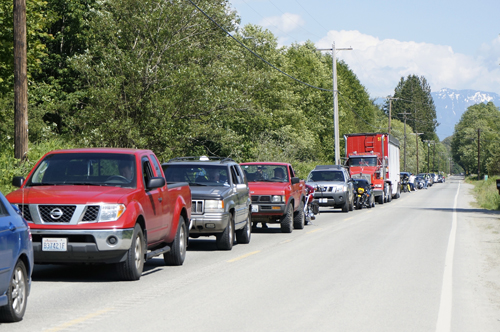By Assunta Ng

Traffic lines up waiting to drive on Highway 530. (Photo by Assunta Ng/NWAW)
It might not be the best time to visit Oso after the mudslide. But I went anyway on May 31 — the opening day for Highway 530 after it was closed for two months.
I have to confess that my motivation is not just for Oso. Seeing my cousin from California, happening to visit a nearby town of Arlington, was my valid excuse. It took an hour to drive from Seattle’s Chinatown to Arlington, and then another 20 minutes to Oso.

Lots in Arlington are big. (Photo by Assunta Ng/NWAW)
I’d never been to Oso. It was a bit unnerving wandering through a disaster area. There were no good reasons for out-of-town visitors to drive to Oso except to satisfy their curiosity.
The 530 Highway only has one lane open. As about 60 cars drove along on the road, another 50 to 60 cars waited on the other side before they got their turn. Passing the mudslide area, the speed limit is 10 mph. No car was allowed to stop. No passengers could get out of their car.

Driving past the mudslide. (Photo by Assunta Ng/NWAW)
It might take just a few minutes to drive through the one-mile-stretch road. But a thousand thoughts rolled down my brain like an avalanche. It’s difficult to look at the massive magnitude of the mudslide. You can’t see the whole area, as some parts are filled with high walls of mud. The land, stripped of the trees, looked naked and bare. I could see a red bag or box, a blue container — debris here and there.

A small tree survived the mudslide. (Photo by Assunta Ng/NWAW)
I sensed the anguish, fear, and pain of the victims in the last few minutes of their lives. I felt the guilt, sorrow, and helplessness of the victims’ families. I imagined how the rescuers broke down during their rescue and recovery work. That part of town would take a long time to rebuild. Could it be rebuilt at all?
After we passed the mudslide, we made a U-turn and drove back. This time, our cameras were clicking during the passing. I told the driver, my son, “Slow down, slow down,” so we could snap more shots from my camera.
I didn’t want to see Darrington — the next destination — although the traffic cop told us to. “Buy something there,” he said. “Darrington needs help.”

A goose family in Arlington. (Photo by Assunta Ng/NWAW)
The green colors and peacefulness of Oso reappeared again after 30 seconds, but I still couldn’t recover from the images I saw 30 seconds earlier. I told myself to shut down that ferocious part of my brain filling with horror. I calmed down, breathed, and enjoyed the sunshine. Soon, I was falling asleep on the road.
You don’t have to go to Darrington or Oso to help the people there. You can donate to United Way or the Red Cross. They are reaching out to residents there. I am proud of the Chinese community, which organized two fundraising events for Oso, raising over $30,000.
Arlington
If you enjoy nature like fishing, hiking through the woods, and living in a big house with a big lot at a reasonable price, Arlington and Oso would be the spots.
Arlington’s population of over 17,000 is much bigger than Oso, which has less than 180 people. It’s quiet with few activities. It’s hard even for retired folks to live there. My retired friends, who claim that Arlington is a boring town, had moved from Arlington a couple years ago.
My cousin and our family had lunch together in downtown Arlington. We passed by a Chinese restaurant, but it was not opened for Saturday lunch. A sign on the door said “Fried Rice for $1.95.” How can a Chinese restaurant survive with that kind of pricing? It takes a lot of ingredients to prepare a fried rice dish.
We went to the restaurant next door called Blue Bird Café. It was packed. Perhaps that’s what small town people look forward to every Saturday — going out to eat. We were the only Asians in the restaurant. The whole town is 3.3 percent Asian.

The food at the Blue Bird Café. (Photo by Assunta Ng/NWAW)
We ordered four entrees (including three dinner entrees of grilled oysters, seafood combinations, and breaded veal), even though it was lunchtime. The entrees all come with soup and dessert. I guess none of the other breakfast and lunch items appealed to us. The food was decent and was served in big portions. We had to abandon our ice cream desserts as we were all stuffed, but we were still content with two boxes of leftovers to take home. We gave one to my cousin, so he didn’t have to cook dinner. Surprisingly, the total bill was only $41.40. (end)



